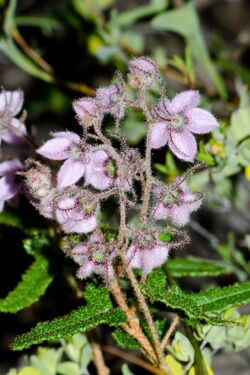Biology:Lasiopetalum venustum
| Lasiopetalum venustum | |
|---|---|

| |
| Scientific classification | |
| Kingdom: | Plantae |
| Clade: | Tracheophytes |
| Clade: | Angiosperms |
| Clade: | Eudicots |
| Clade: | Rosids |
| Order: | Malvales |
| Family: | Malvaceae |
| Genus: | Lasiopetalum |
| Species: | L. venustum
|
| Binomial name | |
| Lasiopetalum venustum K.A.Sheph. & C.F.Wilkins[1]
| |
Lasiopetalum venustum is a species of flowering plant in the family Malvaceae and is endemic to a restricted area in the south-west of Western Australia. It is an erect shrub with hairy stems, egg-shaped, three-lobed leaves and pink and dark red flowers.
Description
Lasiopetalum venustum is an erect shrub typically 0.8–1.5 m (3–5 ft) high and wide, its stems covered with rust-coloured and white, star-shaped hairs, at least when young. The leaves are egg-shaped with three lobes, 13–40 mm (0.51–1.57 in) long and 18–32 mm (0.71–1.26 in) wide on a petiole 4–22 mm (0.16–0.87 in) long. The leaves are covered with white and rust-coloured, star-shaped hairs, densely so on the lower surface. The flowers are arranged in loose groups of four to twelve on a rusty-hairy peduncle 28–72 mm (1.1–2.8 in) long, each flower on a pedicel 4.5–9 mm (0.18–0.35 in) long with a thread-like bract 6–14 mm (0.24–0.55 in) long at the base. There are three thread-like bracteoles 6–12 mm (0.24–0.47 in) long at the base of the sepals. The sepals are bright pink with a dark red base, the lobes egg-shaped, 4–8.5 mm (0.16–0.33 in) long, and hairy on the back. There are no petals, the anthers are dark red with a white tip and 3.6–4.7 mm (0.14–0.19 in) long on filaments about 1 mm (0.039 in) long. Flowering has been recorded from October to January and the fruit is about 3.5 mm (0.14 in) long and hairy.[2][3]
Taxonomy
Lasiopetalum venustum was first formally described in 2015 by Kelly Anne Shepherd and Carolyn F. Wilkins in the journal Nuytsia from specimens collected in Boonanarring Nature Reserve in 2002.[4] The specific epithet (venustum) means "attractive, charming or pretty".[3]
Distribution and habitat
This lasiopetalum is only known from a nature reserve near Gingin, where it grows in woodland among granite boulders.[2][3]
Conservation status
Lasiopetalum venustum is listed as "Priority Three" by the Government of Western Australia Department of Biodiversity, Conservation and Attractions,[2] meaning that it is poorly known and known from only a few locations but is not under imminent threat.[5]
References
- ↑ "Lasiopetalum venustum". https://biodiversity.org.au/nsl/services/apc-format/display/4260838.
- ↑ 2.0 2.1 2.2 "Lasiopetalum venustum". FloraBase. Western Australian Government Department of Parks and Wildlife. https://florabase.dpaw.wa.gov.au/browse/profile/45083.
- ↑ 3.0 3.1 3.2 Shepherd, Kelly A.; Wilkins, Carolyn F. (2015). "A revision of species from the tribe Lasiopetaleae (Byttnerioideae: Malvaceae) with rostrate anthers". Nuytsia 25: 186–188. https://florabase.dpaw.wa.gov.au/science/nuytsia/753.pdf. Retrieved 20 April 2022.
- ↑ "Lasiopetalum trichanthera". APNI. https://id.biodiversity.org.au/instance/apni/4261271.
- ↑ "Conservation codes for Western Australian Flora and Fauna". Government of Western Australia Department of Parks and Wildlife. https://www.dpaw.wa.gov.au/images/documents/plants-animals/threatened-species/Listings/Conservation%20code%20definitions.pdf. Retrieved 20 April 2022.
Wikidata ☰ Q111663237 entry
 |



